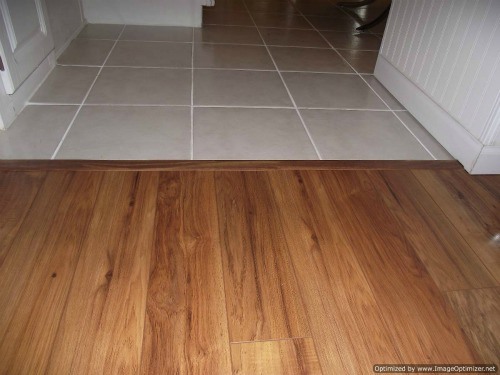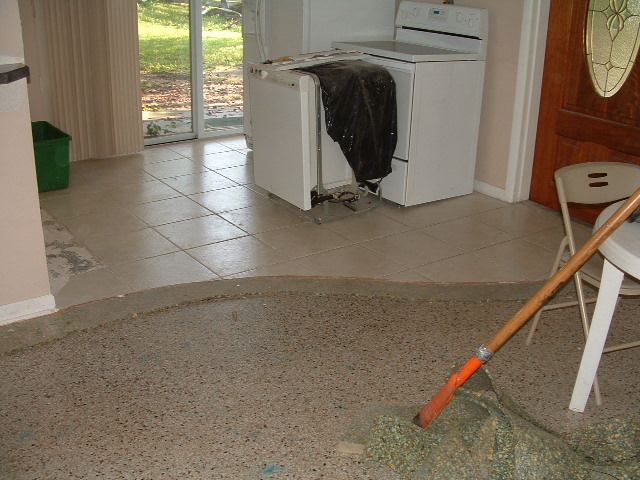Have you ever gazed longingly at your ceramic tile floors, dreaming of a cozy, warm, and inviting wood-look finish without the hassle of a complete demolition? The allure of laminate flooring’s versatility and affordability is undeniable, but can it truly be laid over your existing ceramic tiles? The answer, surprisingly, is a resounding “maybe.” It’s not just a simple question of “yes” or “no”. To truly understand if laminate flooring over ceramic tile is the right choice for you, we need to delve into the intricacies of this unique flooring project.

Image: diy-laminate-floors.wonderhowto.com
This article serves as your ultimate guide, unraveling the pros and cons of installing laminate flooring over ceramic tile. Together, we’ll explore the considerations, best practices, and potential pitfalls that come with this project. Whether you’re a seasoned DIY enthusiast or a first-time homeowner seeking a flooring refresh, this guide will empower you to make informed decisions that align with your aspirations and budget.
Understanding the Terrain: A Deeper Dive
Before diving into the specifics of installing laminate flooring over ceramic tile, it’s crucial to understand the unique characteristics of both flooring types.
Ceramic tile is known for its robustness and durability, resisting moisture and stains. Its smooth, hard surface makes it easy to clean and maintain, making it a popular choice for kitchens, bathrooms, and high-traffic areas. However, ceramic tile can feel cold and unwelcoming underfoot, especially during colder months.
Laminate flooring, on the other hand, offers the look and feel of real hardwood without the hefty price tag. Its versatility allows for endless design options, from classic wood patterns to modern and contemporary aesthetics. However, laminate flooring requires a smooth and level subfloor for optimal installation and performance.
The Pros and Cons: A Weighing of Possibilities
Let’s dissect the advantages and disadvantages of installing laminate flooring over ceramic tile.
Pros:
- Cost-Effectiveness: Installing laminate flooring over existing ceramic tile can significantly reduce the cost and time involved in a complete flooring overhaul. You’re essentially saving on the cost of removing the existing tile, which can be a labor-intensive and messy process.
- Reduced Disruption: This method minimizes disruption to your daily life. Compared to a complete flooring replacement, laying laminate over tiles allows you to stay in your home with minimal inconvenience.
- Versatility: Laminate flooring offers a wide array of styles and colors, replicating the look of wood, stone, or even concrete. This allows you to personalize your space without sacrificing the durability of your existing tile floor.
Cons:
- Subfloor Considerations: The success of this project hinges on the condition and levelness of your existing ceramic tile subfloor. Uneven or cracked tiles can create problems down the line, leading to gaps, unevenness, and potential damage to the laminate flooring.
- Height Increase: Laying laminate over ceramic tile will inevitably increase the overall floor height, which may affect door clearances and necessitate adjustments to trim or door frames.
- Adhesive Challenges: Finding a suitable adhesive for laminate flooring that will bond effectively to ceramic tile can be tricky. The adhesion needs to be strong enough to withstand the weight and movement of the laminate flooring, but also flexible enough to accommodate the expansion and contraction of the materials due to temperature changes.
The Essential Preparation: Setting the Foundation for Success
The success of installing laminate flooring over ceramic tile largely depends on the thoroughness of your preparation. Here are the key steps to ensuring a smooth and durable installation:
- Ceramic Tile Inspection: Start by scrutinizing your existing ceramic tile floor. Look for any loose tiles, cracks, or significant unevenness. Loose or compromised tiles need to be repaired or replaced before proceeding.
- Cleanliness is Key: A thorough cleaning is crucial to remove any debris, dust, dirt, or residue that could hinder the adhesion of the new flooring.
- Surface Leveling: If your existing ceramic tile floor has minor inconsistencies, a self-leveling compound can help create a smooth and level surface for the laminate flooring.
- Moisture Barrier: Installing a moisture barrier over the ceramic tile is vital, especially in areas prone to moisture like bathrooms or kitchens. This barrier prevents moisture from migrating up through the tile and potentially damaging the laminate flooring.

Image: www.laminate-flooring-installed.com
Choosing the Right Adhesive: A Vital Decision
Since a traditional wood subfloor is not present, finding the right adhesive for laminate flooring over ceramic tile is paramount. The adhesive needs to be strong enough to secure the laminate flooring to the ceramic tiles, yet flexible enough to accommodate the expansion and contraction of the materials.
Consult with flooring experts or visit reputable flooring stores to find an adhesive specifically designed for this application. Some common choices include:
- Construction Adhesive: A strong, durable adhesive that provides excellent bond strength.
- Modified Silane Sealant: Offers a high level of moisture resistance and flexibility, making it suitable for areas with potential moisture exposure.
- Epoxy Adhesive: Provides the strongest bond and is moisture-resistant, ideal for high-traffic areas or locations with potential water damage.
Installation Process: The Art of Laying Laminate Flooring
Once your subfloor is prepped, you can proceed with installing the laminate flooring. Here’s a general guideline:
- Starting Off: Choose a starting point for your laminate planks, typically a wall or corner. Ensure sufficient spacing for expansion and contraction of the flooring.
- Laying the First Row: Secure the first row of laminate planks to the ceramic tile using the chosen adhesive. Follow the manufacturer’s instructions for adhesive application.
- Locking System: Interlock the subsequent rows of laminate planks, using the tongue and groove system provided. Be sure to space the boards for expansion as recommended by the manufacturer.
- Cutting and Trimming: Use a saw or utility knife to cut laminate planks to fit against walls or other obstacles.
- Finishing Touches: Install transition strips to bridge the gap between the laminate flooring and other flooring types like carpet or wood.
Potential Challenges: Expect the Unexpected
While installing laminate over ceramic tile can be a feasible option, it comes with potential challenges you should be prepared for:
- Unevenness and Gaps: If the ceramic tile subfloor is not perfectly level, you may encounter unevenness or gaps in the laminate flooring.
- Sound Transfer: Ceramic tile is a hard material, and sound can easily travel through it. Consider using an underlayment material to cushion the laminate flooring and reduce noise transmission.
- Moisture Issues: Even with a moisture barrier in place, moisture intrusion is a potential issue. Ensure proper ventilation and address any potential water leaks promptly.
Expert Insights: Tips from the Pros
To gain valuable insights into installing laminate flooring over ceramic tile, we reached out to renowned flooring expert, Sarah Thompson from [Name of Flooring Company] who shared her expertise:
“The key to a successful installation lies in ensuring a robust and level subfloor. Paying meticulous attention to preparation and using the right adhesives is crucial for long-lasting results. Seek advice from flooring professionals to select the most suitable underlayment and make informed decisions regarding moisture control.”
Actionable Advice: Empowering Your Flooring Journey
Here are some actionable tips based on expert insights to make your laminate flooring project a success:
- Consult a Professional: If you are not confident in your DIY skills or have concerns about the complexity of the project, seeking professional help from a licensed contractor or flooring specialist is recommended.
- Inspect, Repair, and Prepare: Thoroughly inspect your existing ceramic tile floor, address any issues, and prepare the surface with meticulousness for optimal results.
- Choose the Right Adhesive: Select an adhesive specifically designed for laminate flooring over ceramic tile. Explore various options and consult with professionals for recommendations.
- Prioritize Moisture Control: Install a moisture barrier to protect your laminate flooring from potential moisture damage.
Can Laminate Flooring Be Installed Over Ceramic Tile
Wrapping it Up: A Flourishing Flooring Solution
Installing laminate flooring over ceramic tile offers a compelling alternative to a complete flooring replacement, potentially saving time, money, and disruption. By carefully weighing the pros and cons, understanding the essential preparation steps, and heeding expert advice, you can transform your ceramic tile floors into a warm and stylish space. As you embark on your flooring journey, don’t hesitate to seek guidance from professionals, embrace the challenges, and celebrate the transformative beauty of a well-executed project.






